When it comes to travel, there are two types of places in the world – popular hotspots and off-the-beaten-path destinations. Countries like Spain and Thailand guarantee a fun time while lesser known destinations pose more of a risk.
Bosnia and Herzegovina, a European country in the Balkan peninsula, is an example of the latter. You never know what to expect from countries untouched by mass tourism, but the rewards, as many people have found, can often be greater. For some people, this is real travel.
Relatively unexplored and overshadowed by the popularity of neighboring Croatia, Bosnia and Herzegovina is home to medieval villages, rolling hills, waterfalls, and centuries old ruins. It’s also home to fantastic food.
If you have a taste for the unknown and enjoy Balkan cuisine, then check out these twenty traditional Bosnian foods when you visit Bosnia and Herzegovina.
BOSNIAN FOOD QUICK LINKS
If you’re visiting Bosnia and Herzegovina and want to learn more about the cuisine, then you may be interested in joining a food tour.
TOURS & OTHER SERVICES
Save This on Pinterest!
No time to read this Bosnian food guide now? Click on the save button and pin it for later!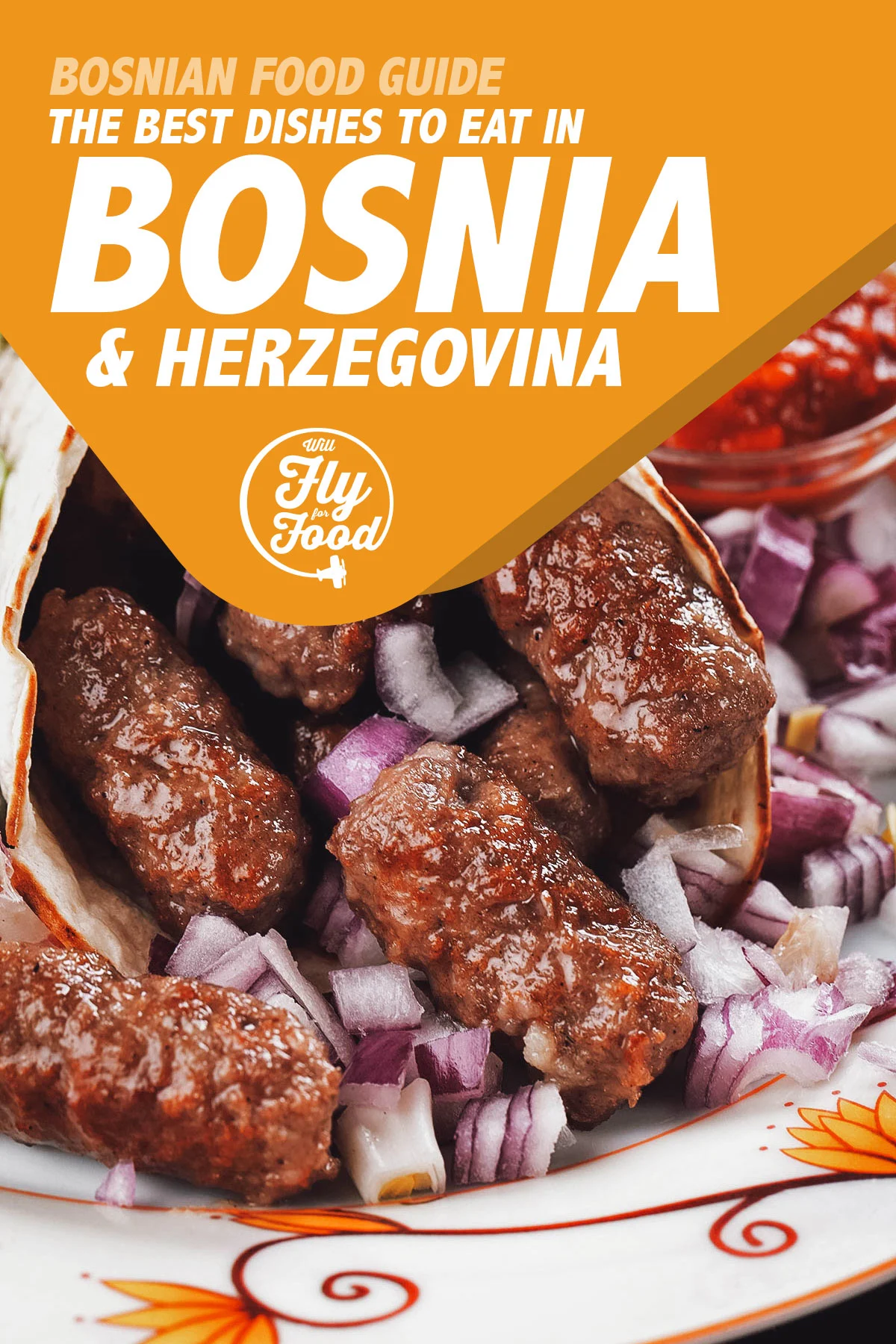
Photo by igordutina
WHAT IS TRADITIONAL BOSNIAN FOOD?
Traditional Bosnian food shares many similarities with its Balkan neighbors. It’s described as a balance between western and eastern influences and is closely related to Turkish and Mediterranean cuisines.
Bosnian cuisine makes use of many spices in moderate quantities. Dishes are often boiled and flavored with sauces made from the natural juices of vegetables.
Common ingredients used in Bosnian cooking include potatoes, bell peppers, tomatoes, onions, cabbage, mushrooms, eggplant, and plums. Paprika is an often used seasoning while meat dishes are typically made with beef, lamb, and poultry.
In Bosnian cuisine, recipes for many traditional dishes have been passed down through the generations and remain relatively unchanged.
THE BEST OF BOSNIAN CUISINE
This Bosnian food guide has been organized by category to make it easier to go through. Click on a link to jump to any section of the guide.
SOUPS / STEWS
1. Bosanski Lonac
There’s no better way to start this Bosnian food guide than with bosanki lonac, the national dish of Bosnia and Herzegovina. Also known as “Bosnian pot”, it’s a popular type of vegetable stew that’s been consumed in the country for many centuries.
Recipes for this beloved Bosnian dish vary greatly from cook to cook and region to region, but it typically consists of a variety of vegetables and chunks of meat. Some of the most commonly used vegetables include bell peppers, potatoes, cabbage, carrots, tomatoes, garlic, and parsley. Different types of meat can be used though beef, lamb, and veal are the most popular.
Bosnian pot is a dish that’s enjoyed across all social classes in the country. Wealthy Bosnians enjoy it with more meat and other expensive ingredients while less affluent people make it with whatever’s available. Traditionally, it was made in clay pots that were cooked in a fireplace or buried in a pit underground, but these days, it’s common to cook it in a pot on a stove.
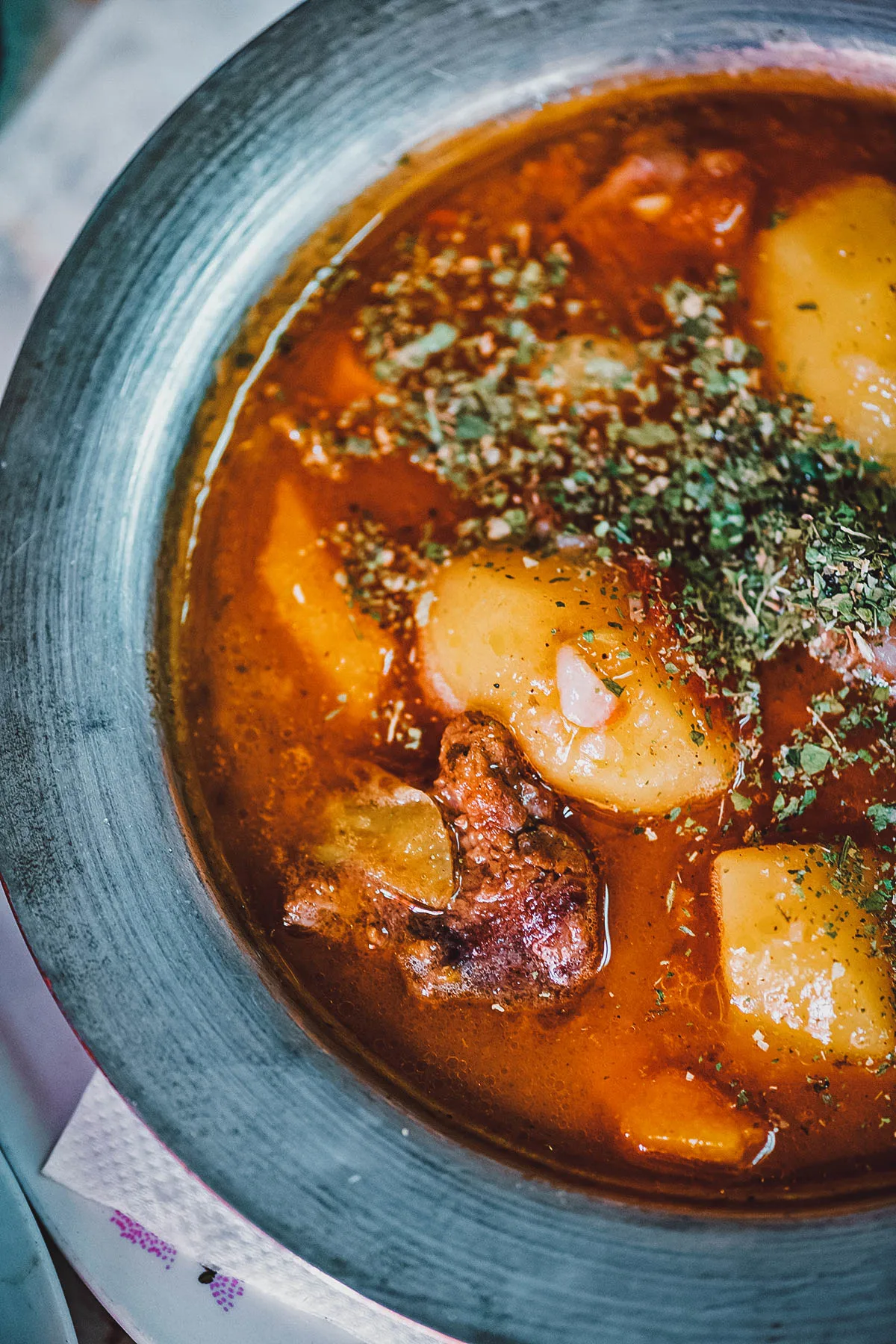
Photo by Wirestock
2. Buranija
Buranija (or boranija) refers to both the Bosnian stew and main ingredient used to make it – Romano beans. Romano beans are a variety of green bean similar to snapping beans.
Buranija is similar to goulash or paprikash but lighter. It’s often made with chunks of veal though it can be made with just vegetables as well like carrots, potatoes, onions, and garlic. The ingredients are seasoned with paprika, bay leaves, salt, and pepper and left to simmer for hours until the meat becomes very tender.
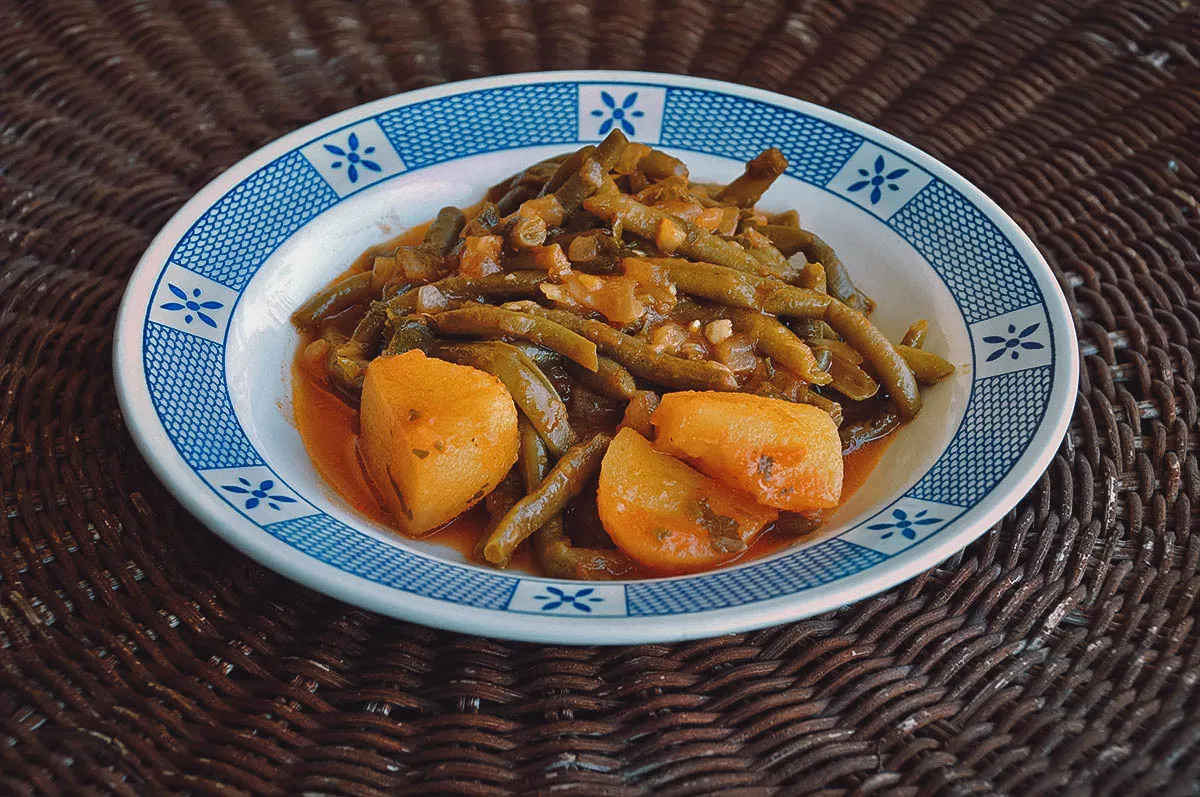
Photo by sirylok
3. Đuveč
Đuveč refers to a type of Bosnian vegetable stew similar to ratatouille. Popular throughout the Balkans, it’s made with a host of different vegetables, herbs, and spices like tomatoes, peppers, onions, carrots, peas, paprika, and summer savory.
The name đuveč is derived from the Turkish word güveç, meaning “earthenware pot”. It can be used to refer to the family of earthenware pots common in Balkan, Levantine, and Turkish cuisines, as well as to the various stews and casserole dishes cooked in them.
Đuveč is often vegetarian but it can be made with various meats like chicken, pork, and lamb as well. It can also be made with rice.
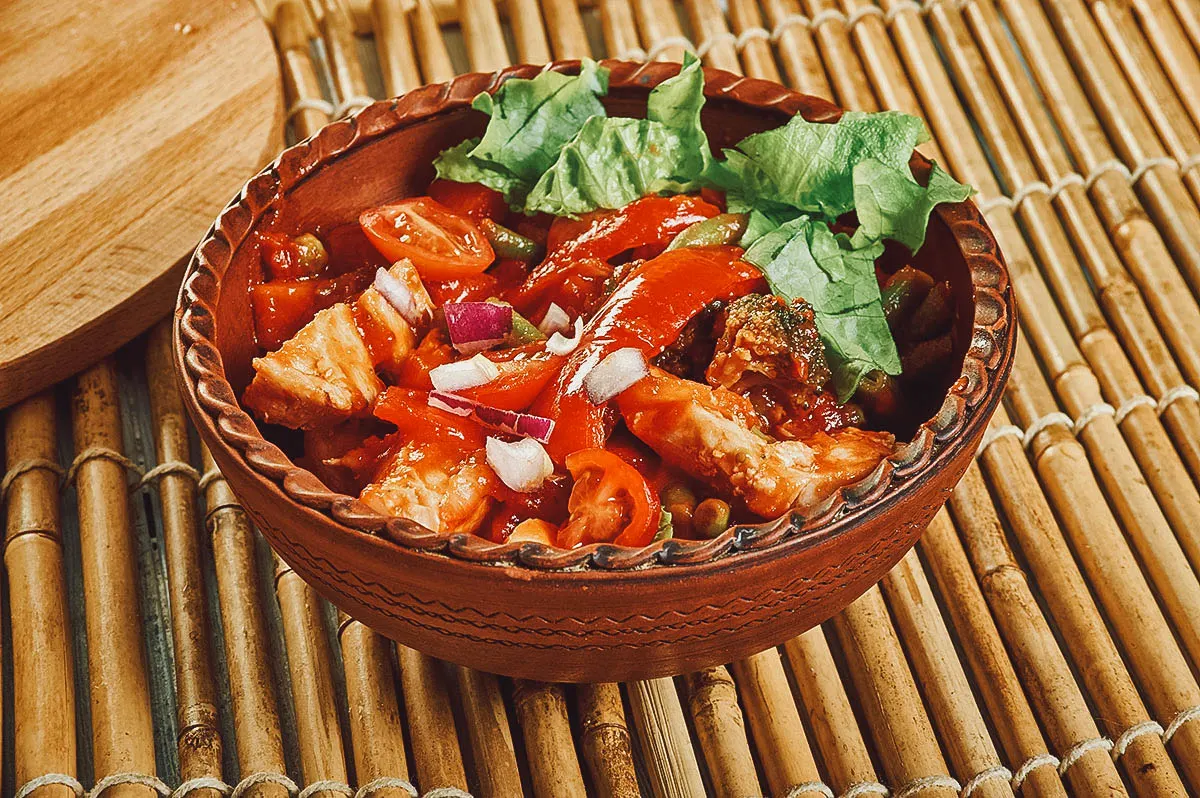
Photo by fanfon
When cooked with rice, đuveč resembles jambalaya or risotto.
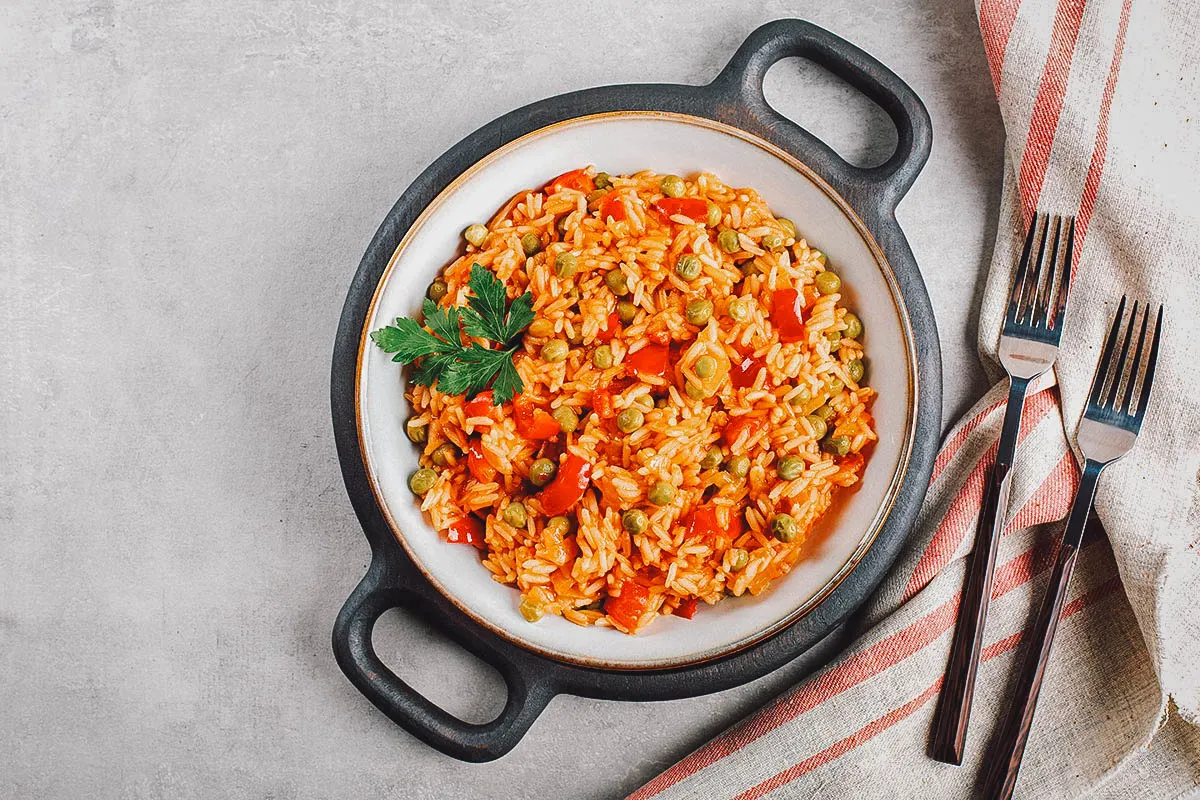
Photo by OlgaBombologna
4. Prebranac
Prebranac is a staple Bosnian dish that’s also popular in Serbian and Macedonian cuisines. It’s a type of casserole made with white beans and caramelized onions seasoned with paprika, garlic, and bay leaves.
Pebranac is a cheap and filling dish that was originally made by farmers to get them through the long winters. Recipes vary from family to family as it’s the type of dish that’s passed down through the generations. A classic Balkan comfort food, it’s typically served at room temperature with warm crusty bread.
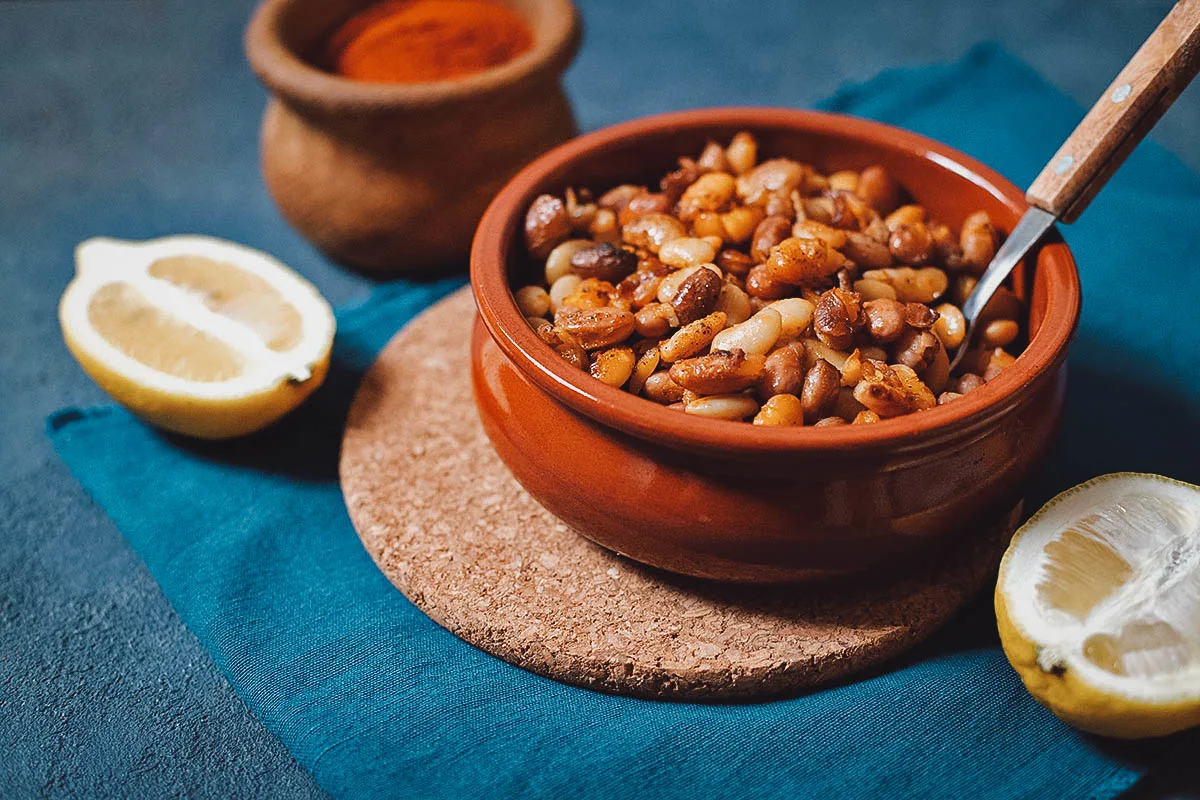
Photo by DariaKM
BREADS / PASTRIES
5. Lepinja va Cevapi
Lepinja (or lepinje, somun) refers to a type of flatbread popular in the cuisines of Bosnia and Herzegovina, Serbia, and Croatia. It’s an everyday type of bread that’s commonly served with cevapi, hence the name lepinje za cevapi which means “flatbread for cevapi”.
Soft and light, lepinja looks like pita bread but it’s closer in texture to focaccia. It’s made with milk which helps give it that soft texture and mild creamy flavor.
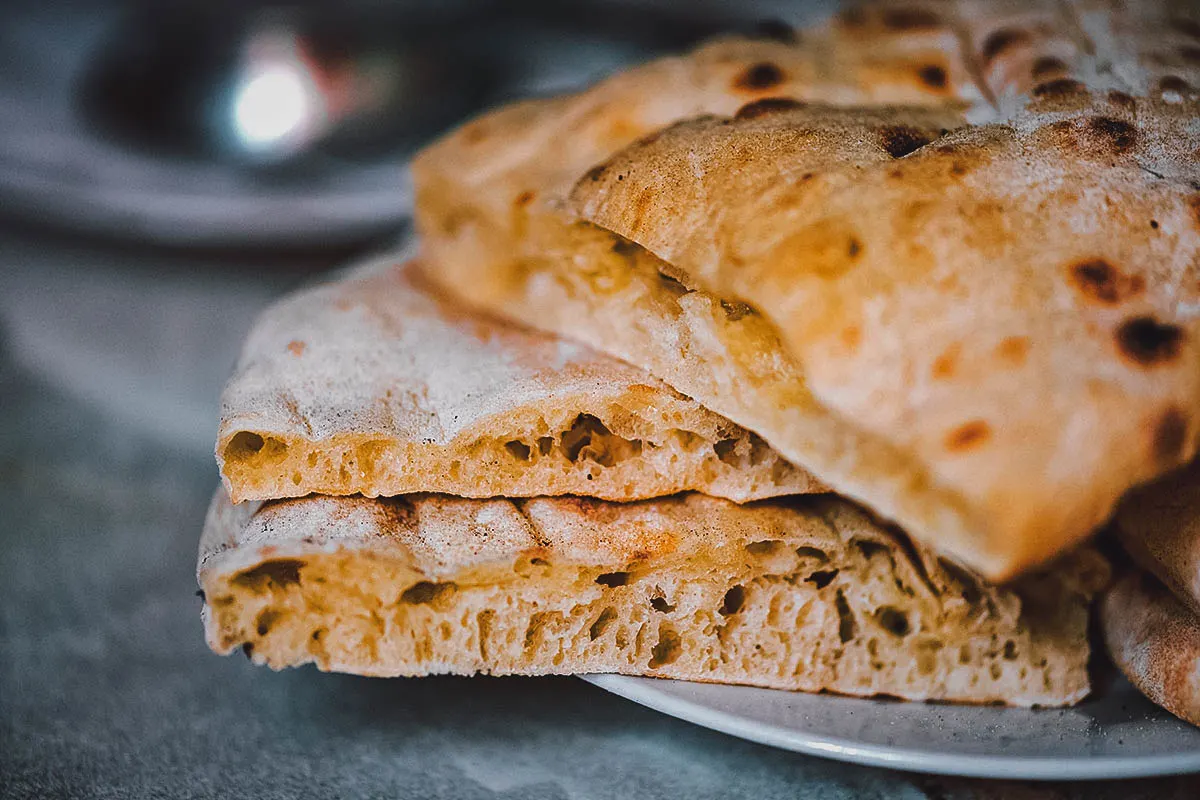
Photo by Wirestock
6. Proha
Proha (or proja) is a type of corn bread popular in the Balkans, particularly in Bosnia and Herzegovina, Serbia, and North Macedonia. Cheap and easy to make, it was originally regarded as peasant food as it helped sustain rural families during the hardships that followed the Second World War.
Proha was originally made with just cornmeal, water, and salt, but today’s versions are made with cornmeal, wheat flour, eggs, vegetable oil, and sparkling water which helps aerate and lighten the batter. It was traditionally made in large baking pans and cut into flat squares, but it’s also common to find them in the form of muffins and small balls.
Rich and dense, proha can be eaten on its own or as a side dish with soups, salads, and saucy Bosnian dishes like sarma. It can be topped or stuffed with cheese and garnished with a variety of ingredients like ham, bacon, spinach, or zucchini.
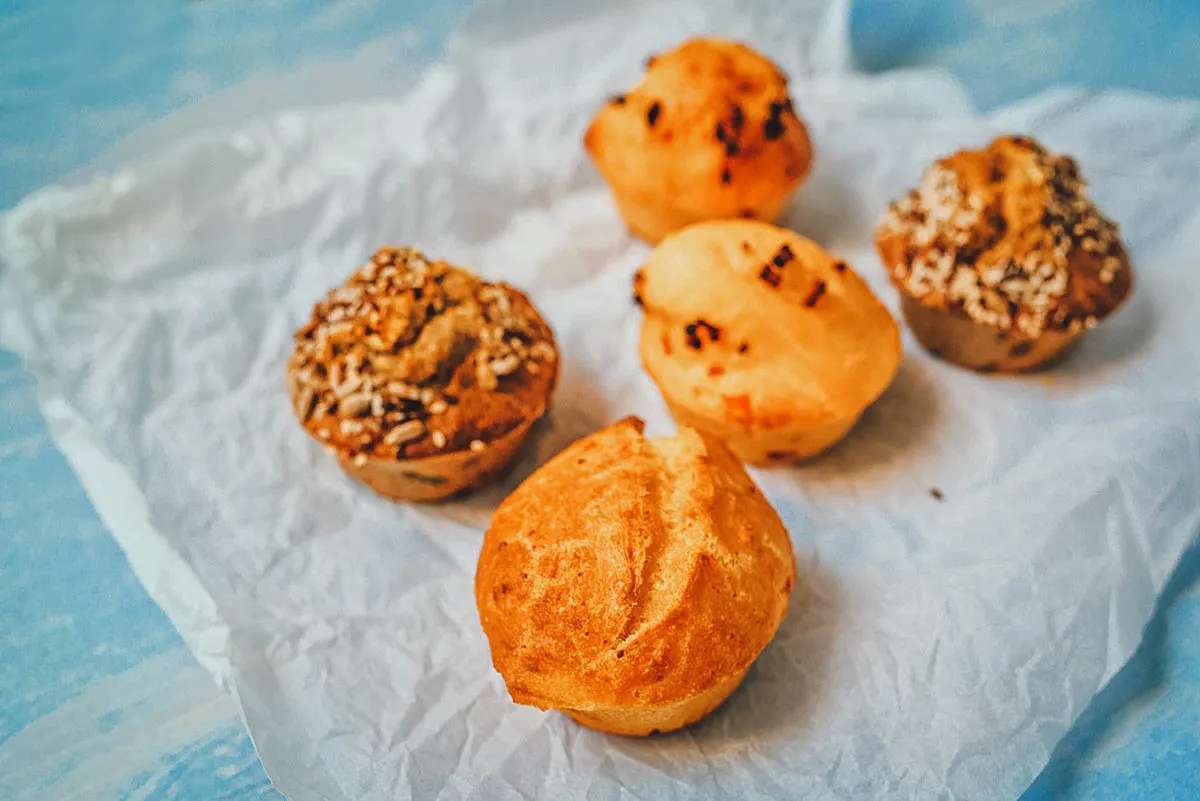
Photo by stevanovicigor
7. Burek
Burek refers to a family of baked filled pastries made with a thin flaky dough stuffed with a variety of ingredients like meat, spinach, potatoes, or cheese. It’s popular in the cuisines of the Balkans, the South Caucasus, Central Asia, and the Levant where it goes by different names like börek and bourekas.
Burek exists in many forms. It can be prepared in a large pan and cut into smaller portions after baking, or it can be made as individual pastries. The exact origins of the dish are unclear, though it’s believed to be a Turkish dish that originated from the kitchens of the Ottoman Empire.
In Bosnian cuisine, burek needs to be made with meat to be considered a true burek. Otherwise, it’s referred to as “pita”. It’s typically baked in spiral form before being cut and served in individual portions. It can also be filled with other ingredients like cottage cheese (sirnica) and potatoes (krompiruša).
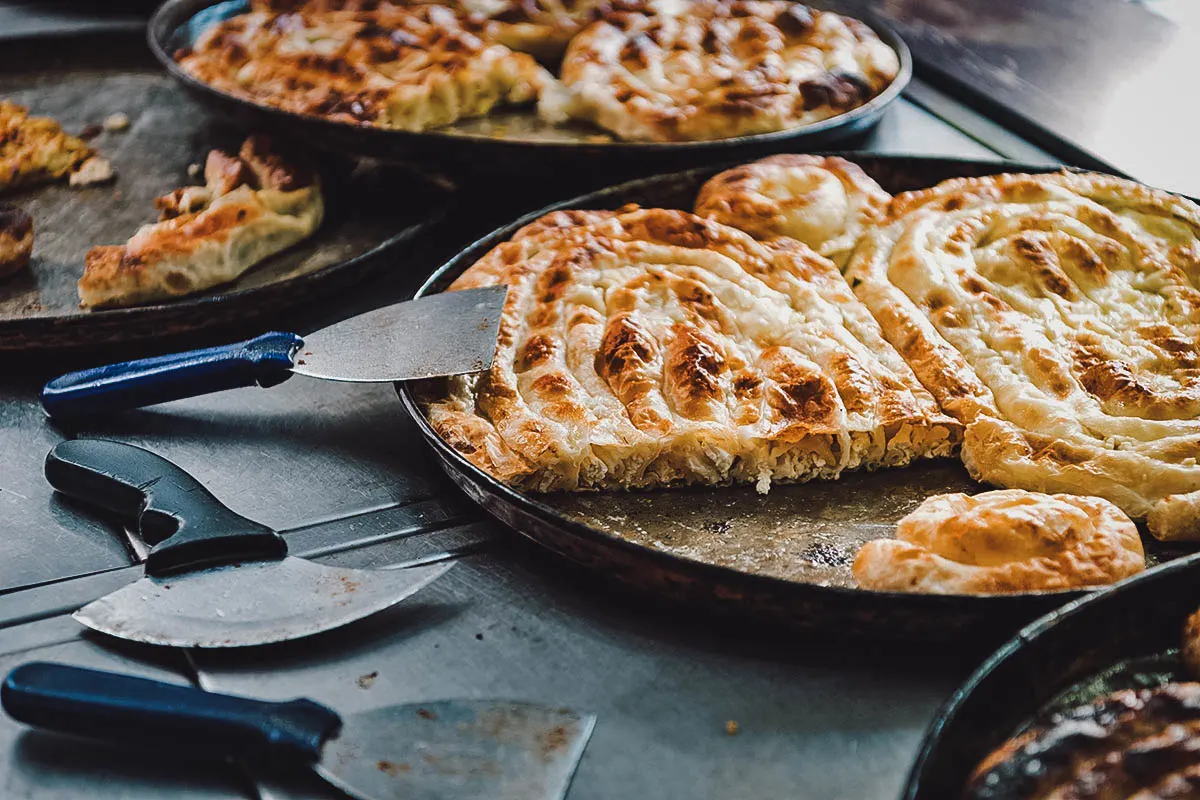
Photo by Wirestock
Pictured below is zeljanica, a type of Bosnian “pita” filled with spinach and cheese.
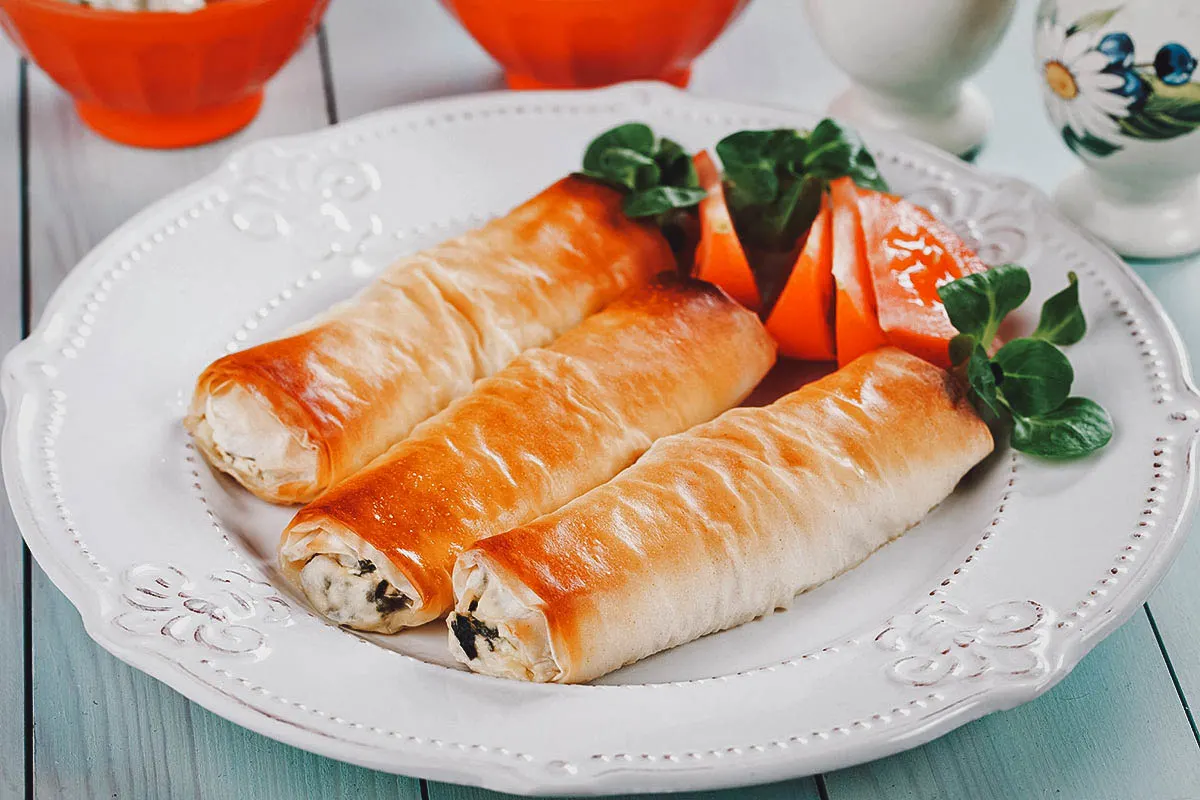
Photo by igordutina
MEATS / MAINS
8. Dolma
Dolma refers to a family of stuffed vegetables dishes popular in Armenia, Georgia, Lebanon, and many other countries throughout the Balkans, the South Caucasus, Central Asia, and the Middle East. It means “stuffed” or “filled” in Turkish and was historically part of Ottoman palace cuisine.
Dolma is made with some type of vegetable that’s been hollowed out and stuffed with a seasoned filling of rice, meat, and other ingredients. Any type of vegetable like bell peppers, tomatoes, zucchini, onions, and eggplant can be stuffed and made into dolma.
One of the most common types of dolma is punjene paprike (pictured below). It’s made with roasted sweet peppers filled with a mixture of rice, ground beef, garlic, onion, paprika, and black pepper.
I’ll get to it in the next entry of this Bosnian food guide but it’s important to note that there exists a sub-type of dolma called sarma. It’s made with the same filling but instead of being stuffed in a hollowed out vegetable, it’s wrapped in a cabbage or vine leaf.
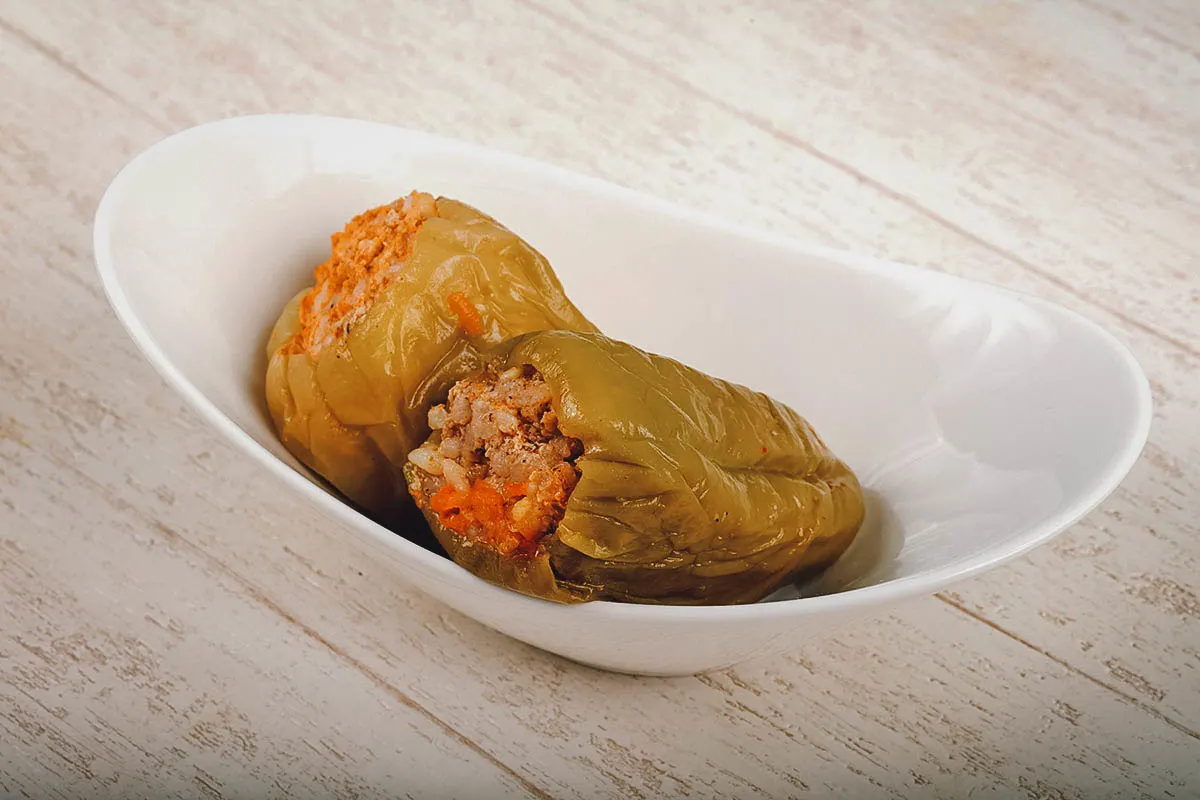
Photo by AndreySt
Originally from the city of Mostar, one type of Bosnian dolma that you need to try is sogan-dolma. It’s a type of dolma made with the layers of an onion filled with a mixture of minced beef, rice, tomato puree, paprika, strained yogurt, sour cream, and spices.
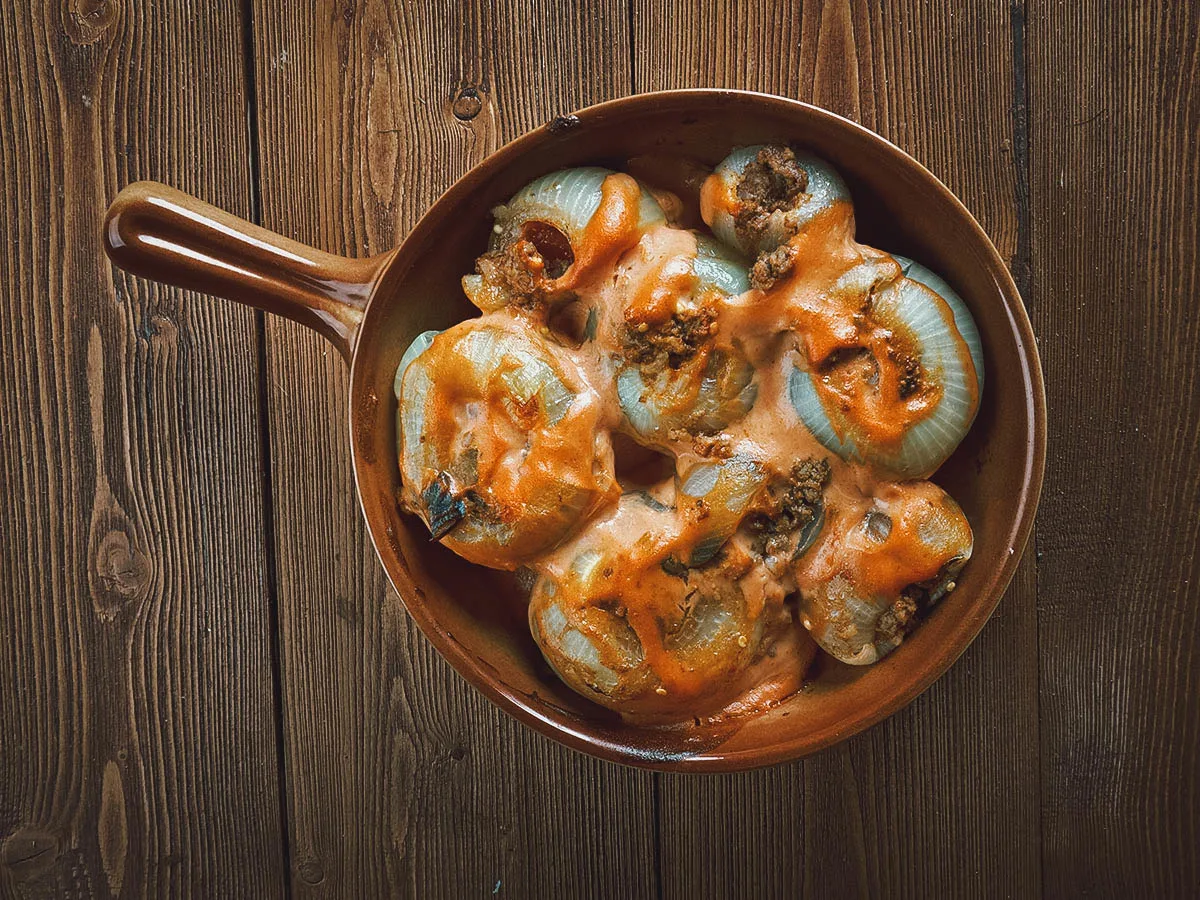
Photo by fanfon
9. Sarma
Sarma is a type of wrapped dolma. As described above, it’s made with the same ground meat and rice filling but instead of being stuffed in vegetables, it’s wrapped in pickled cabbage or vine leaves instead. Dolma means “stuffed” or “filled” while sarma means “rolled” or “wrapped”.
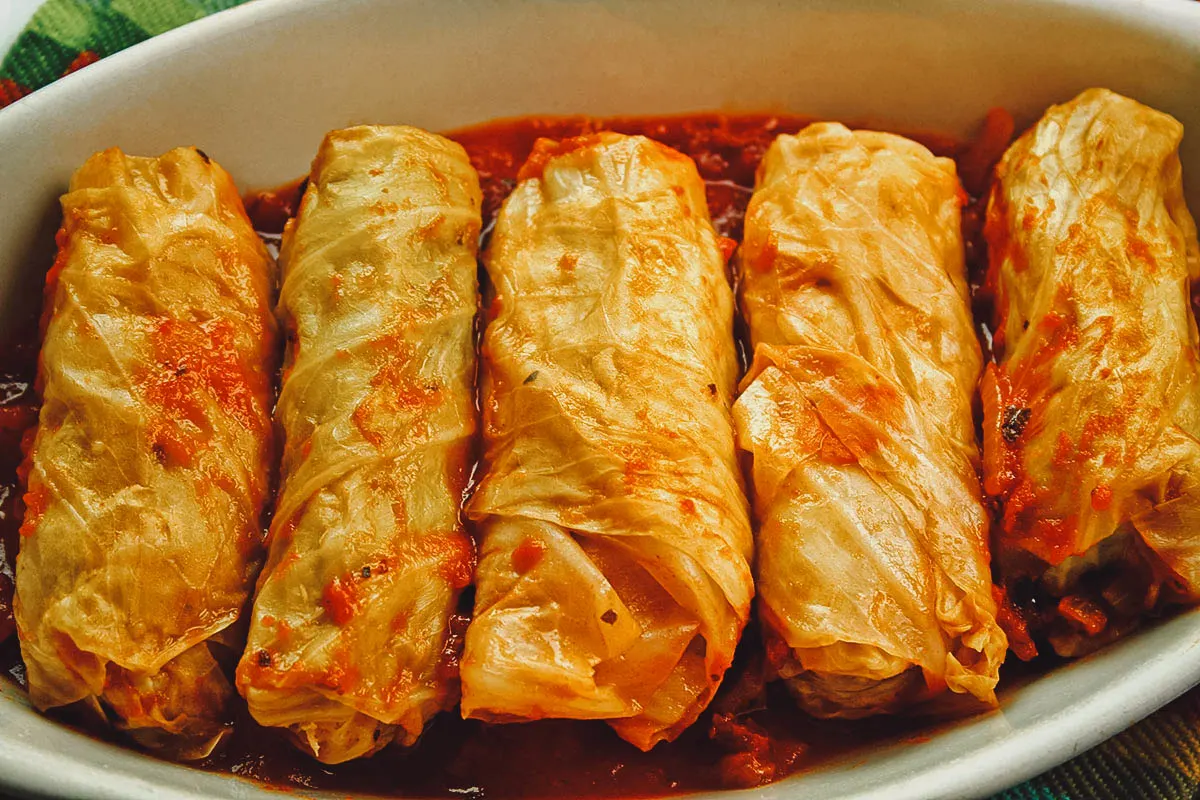
Photo by jabiru
Sarma made with stuffed grape leaves is one of the most popular versions of dolma. In Greece, they’re known as dolmadakia or dolmades. In Bosnian cuisine, they’re known as Hercegovački japrak or Herzegovinian japrak.
Traditionally, Hercegovački japrak is made with blanched raštika leaves – a local type of leaf cabbage – but it can be made with grape leaves as well. The stuffed leaves are cooked for hours and often served with mashed potatoes or sour cream.
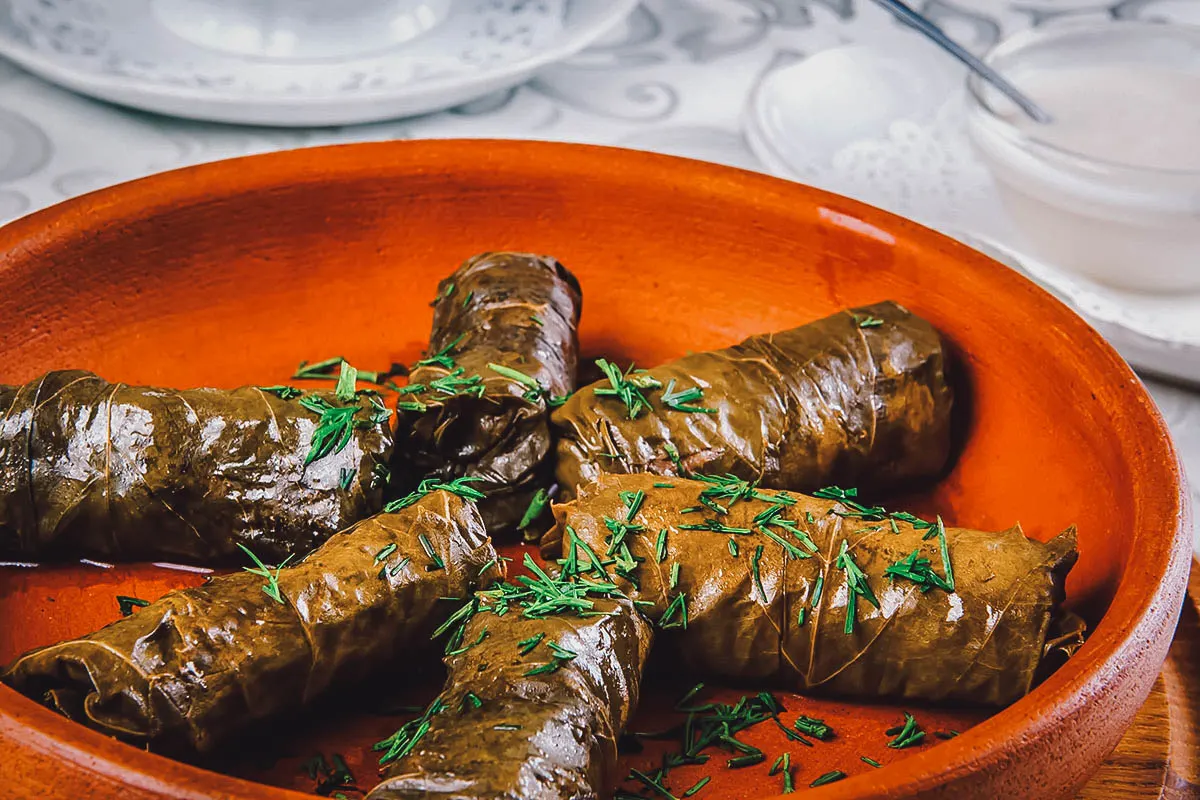
Photo by lvssvl1
10. Klepe
Klepe (or kulaci) are Bosnian meat-filled dumplings. Traditionally made with flour, eggs, salt, and a seasoned meat and onion filling, you can think of them as the Bosnian equivalent of ravioli or manti.
To prepare, the dumplings are formed by hand and then boiled for about 10-12 minutes. They can be lightly sauteed in a pan before being baked in an oven with sauces made from sour cream, heavy cream, garlic, paprika, and butter.
Traditionally, klepe are made with a ground beef filling but more modern variations can be stuffed with a variety of ingredients like cheese, spinach, or chicken. They’re best enjoyed straight from the oven.
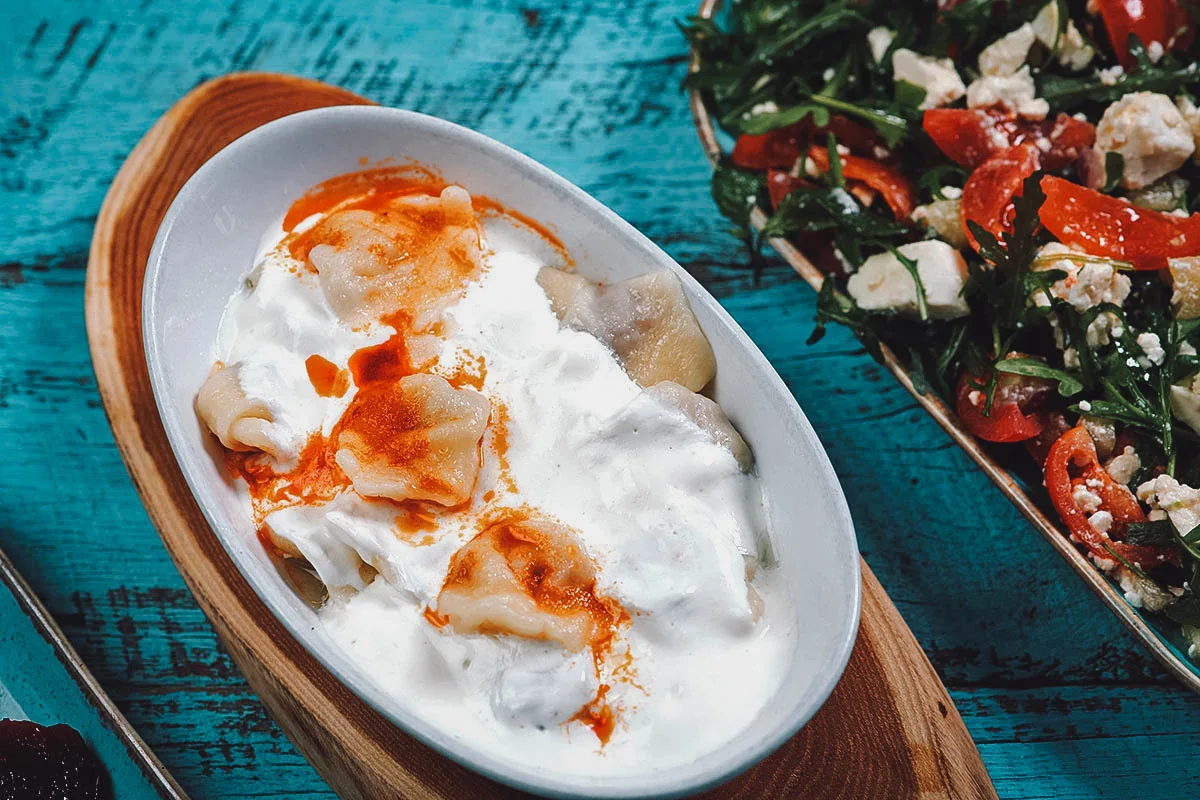
Photo by .shock
11. Ćevapi
No Bosnian food guide can ever be complete without ćevapi, a hugely popular dish of grilled minced meat. It’s considered a Bosnian national dish and is equally popular in the cuisines of neighboring countries like Serbia, Croatia, Albania, Kosovo, Montenegro, and Slovenia.
Variations of ćevapi (or ćevapčići) exist throughout the Balkans but the Bosnian version is typically made with two types of minced beef meat hand-mixed and formed using a funnel. They’re typically served in portions of 5-10 sausages with lepinja, chopped onions, ajvar (bell pepper relish), sour cream, kajmak (simlar to clotted cream), and cottage cheese.
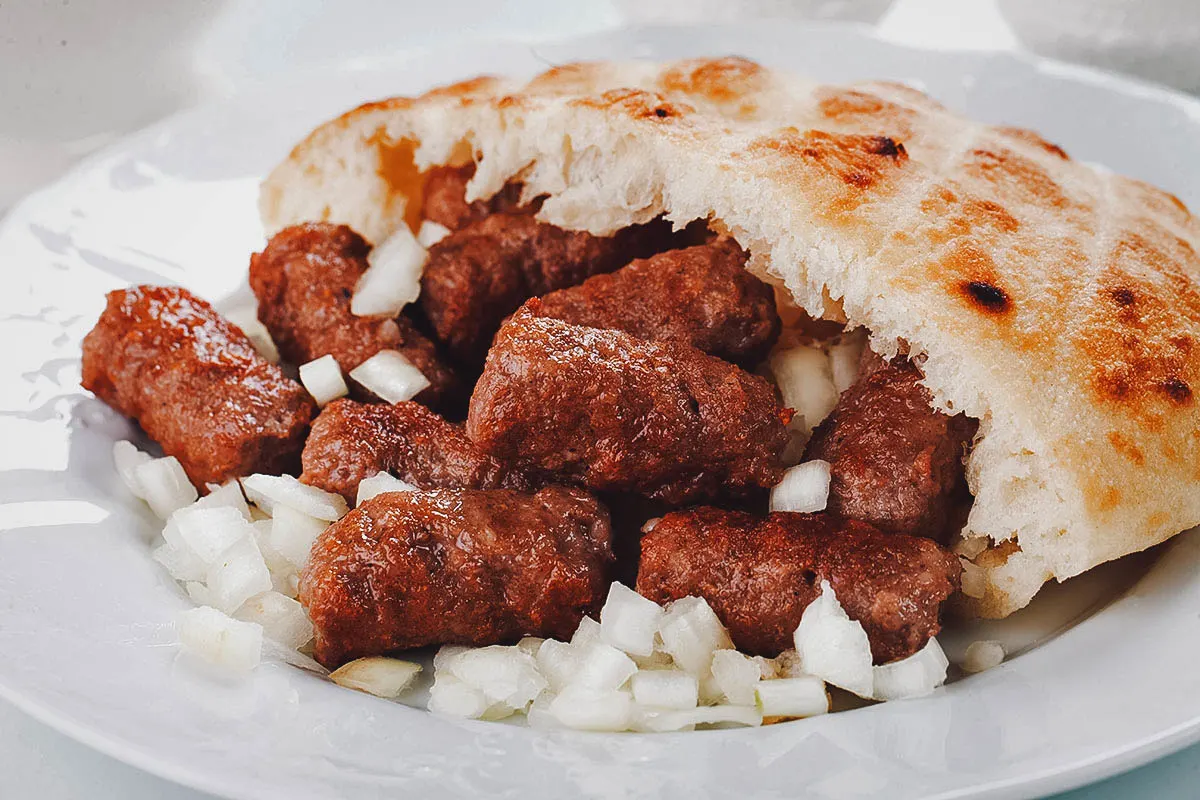
Photo by igordutina
12. Suho Meso
Suho meso literally means “dry meat” and refers to a type of smoked beef or pork popular in Serbian, Montenegrin, Croatian, and Bosnian cuisine.
To make suho meso, meat is cured in coarse salt before being dried and smoked for several days or weeks over an oak fire. It’s typically prepared in winter to keep the meat from spoiling.
Similar to pastirma, suho meso is a staple dish in many Bosnian celebrations and feasts.
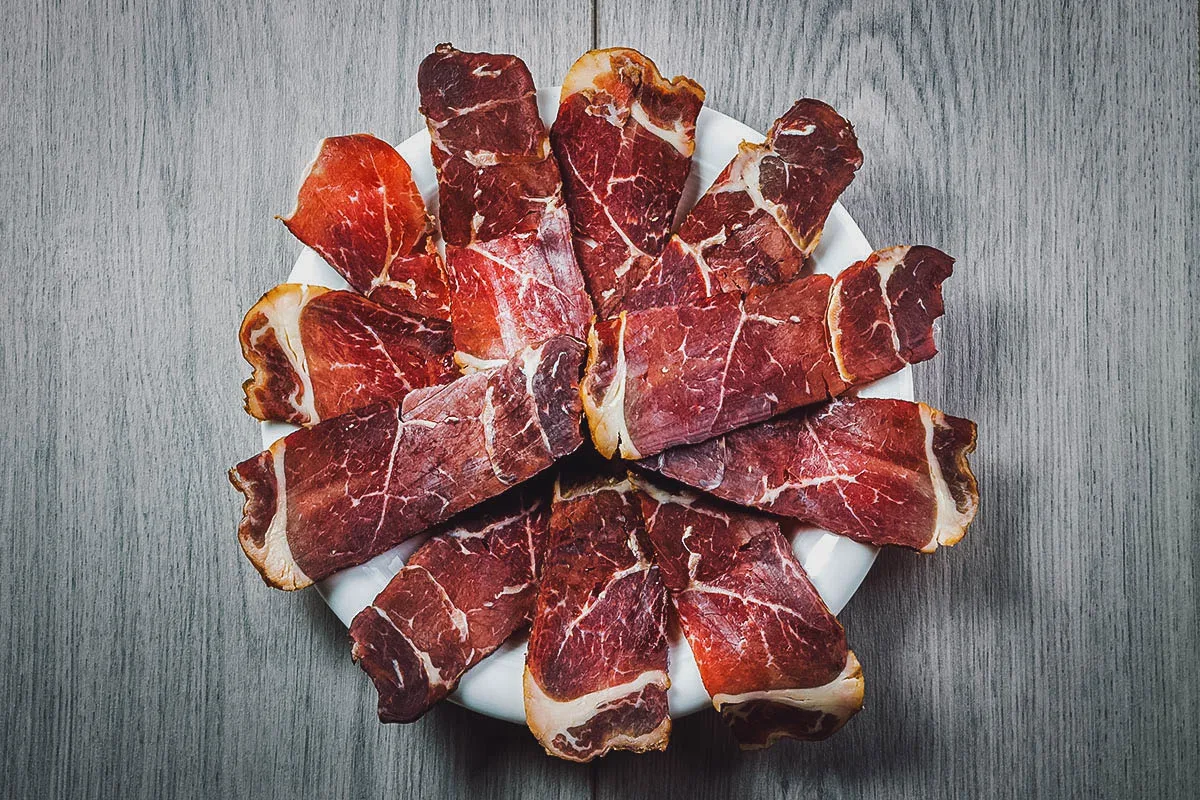
Photo by NedoB
13. Pljeskavica
Like ćevapi, pljeskavica is a grilled meat dish that’s extremely popular in many Balkan countries like Bosnia and Herzegovina, Croatia, North Macedonia, and Montenegro. It’s especially popular in Serbia where it’s considered a national dish.
You can think of pljeskavica as the Balkan equivalent of a hamburger. The patty mixture is similar to ćevapi and it’s often served in lepinja flatbread with onions, ajvar, kajmak, and urnebes (spicy cheese salad).
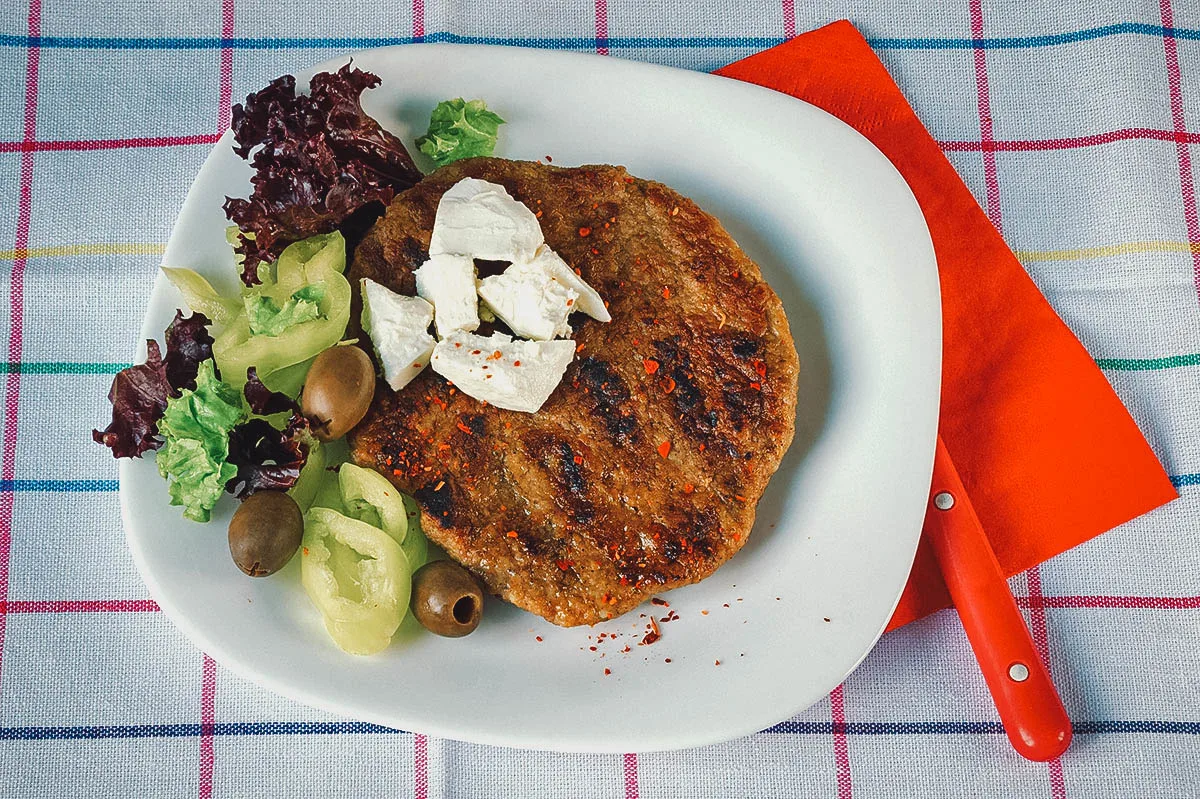
Photo by OlgaIlinich
14. Musaka
As you can probably tell by now, many of the dishes in this Bosnian food guide are popular throughout the Balkans. Musaka is no exception. It’s a ground beef and potato casserole popular in the cuisines of Bosnia and Herzegovina, Serbia, Croatia, and North Macedonia. You can think of it as the Balkan equivalent of moussaka.
Unlike Greek moussaka, Bosnian musaka usually isn’t made with eggplant or bechamel. Instead, it’s made with potato rounds and seasoned ground beef. The ingredients are layered, baked, and then finished off with a topping made from egg and sour cream.
It’s worth mentioning that Bosnian musaka can be made with eggplant as well, though this is usually the exception, not the norm.
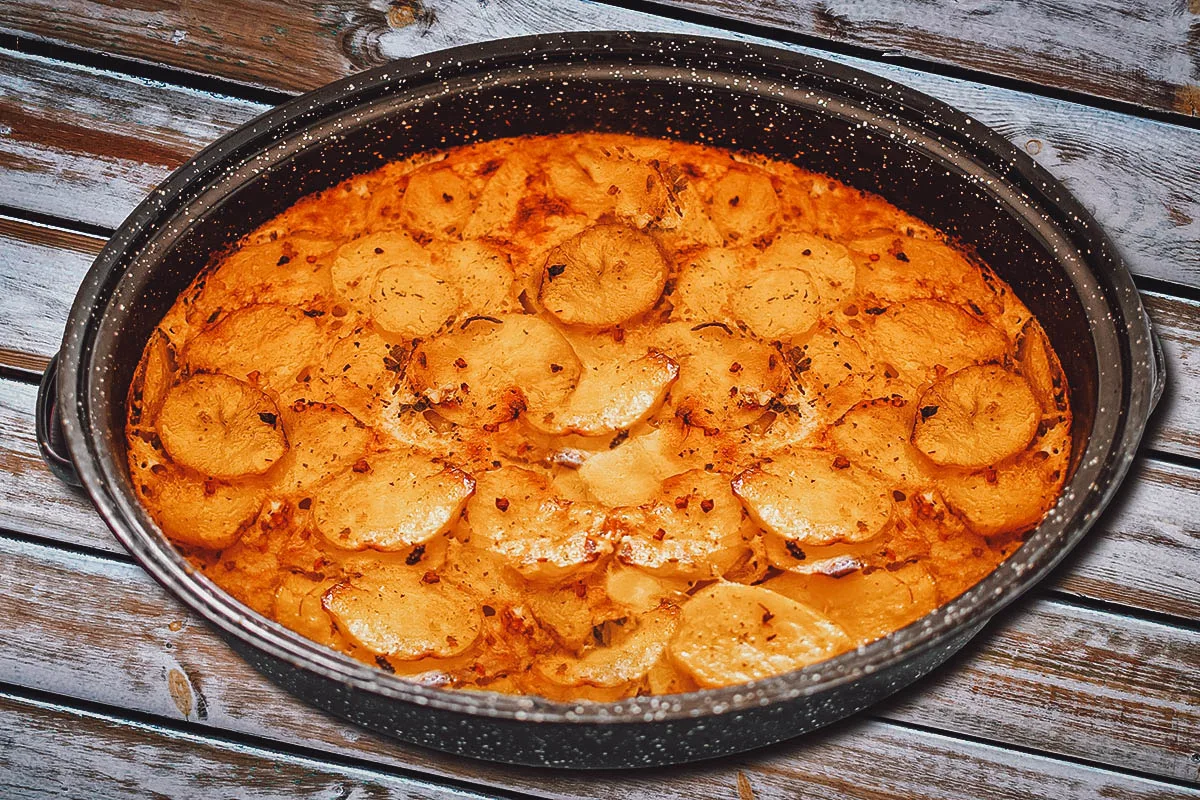
Photo by Bennian
15. Peka
Peka doesn’t refer to a particular dish, but a cooking device used to prepare a variety of meat, seafood, and vegetable dishes. You can think of it as a primitive type of convection oven.
Also known as a sač, a peka is a cooking vessel with a bell-shaped lid made from cast iron or clay. It’s used outdoors to cook a variety of dishes over and under hot charcoal (see next picture). This dual heat source, together with the shape of the vessel, allows steam to recirculate so dishes are cooked slowly and more evenly. It also allows dishes to be lightly smoked.
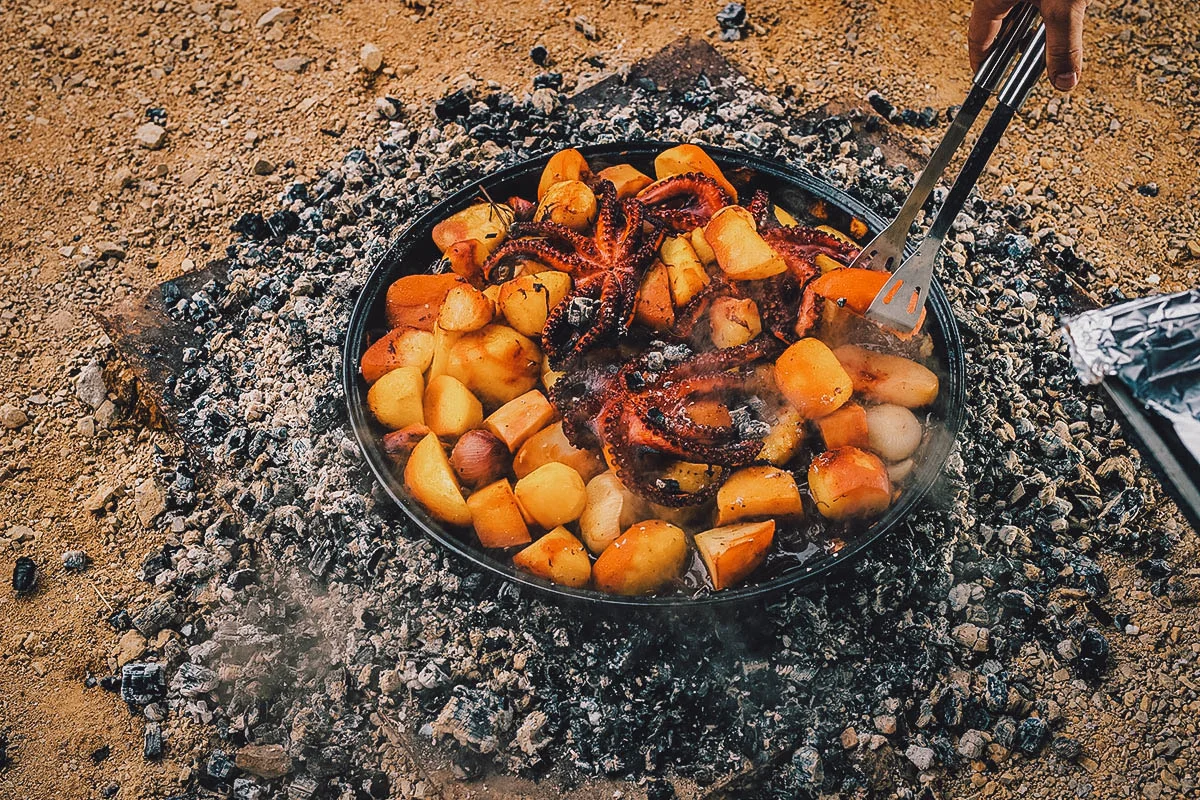
Photo by psgt_123
Here’s a picture of the lid topped with live charcoal. Note the ring that keeps the charcoal in place.
The peka is popular throughout the Balkan peninsula and can also be used to bake bread and traditional pastries like burek. Bread can be baked on top of the lid or inside the vessel.
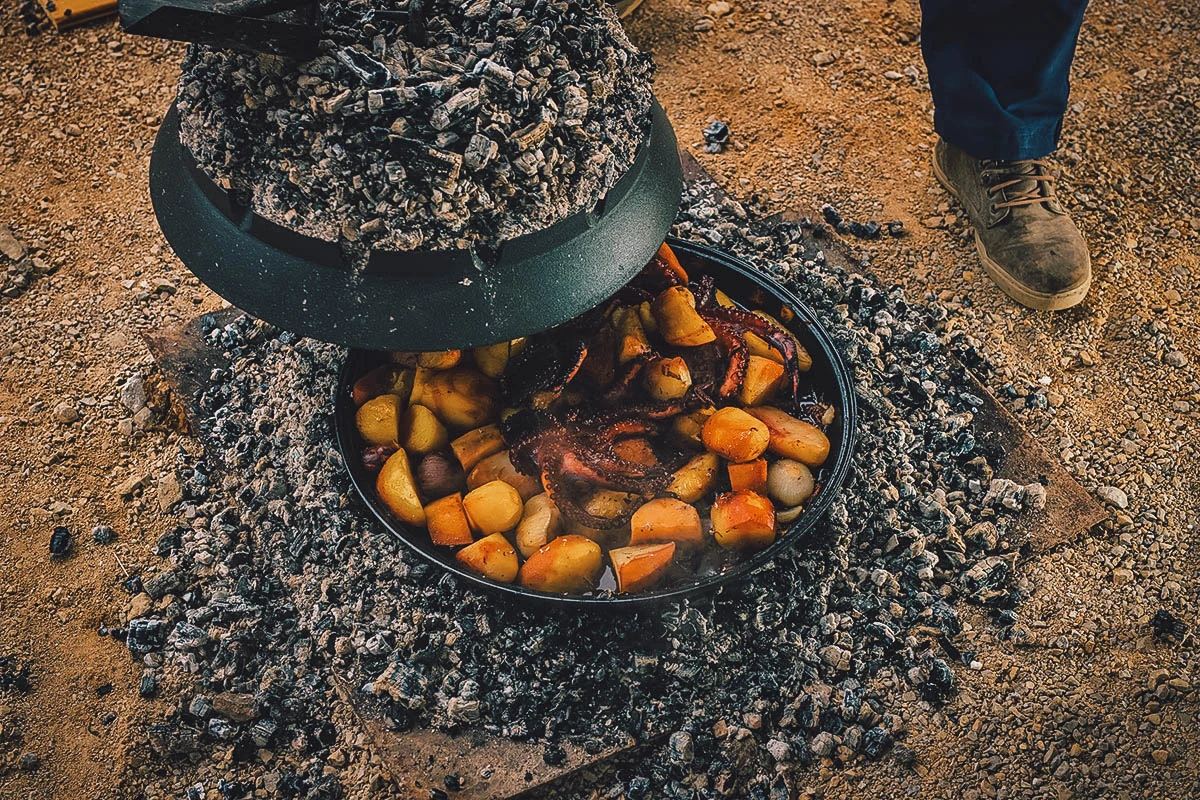
Photo by psgt_123
DESSERT / DRINKS
16. Baklava
If you like desserts, then chances are you’re already a fan of baklava. It’s a hugely popular dessert made with layers of phyllo pastry and chopped nuts sweetened with syrup or honey.
Baklava is a common dessert in many countries like Turkey, Lebanon, Armenia, Azerbaijan, and Iran. It’s consumed throughout the Balkans, the South Caucasus, Central Asia, and the Levant. Its exact origins are unclear but the modern version of this beloved dessert is believed to have originated from the kitchens of the Ottoman Empire.
Because it’s so widely consumed, baklava exists in many variations. In Bosnian cuisine, it’s typically made with sheets of phyllo pastry, chopped walnuts, and agda – a simple syrup made from sugar, water, lemon, and vanilla.
You’ll also find a Bosnian version of baklava called ružice or đul-pita. It’s shaped into a roll and cut into portions that resemble roses or rosebuds.
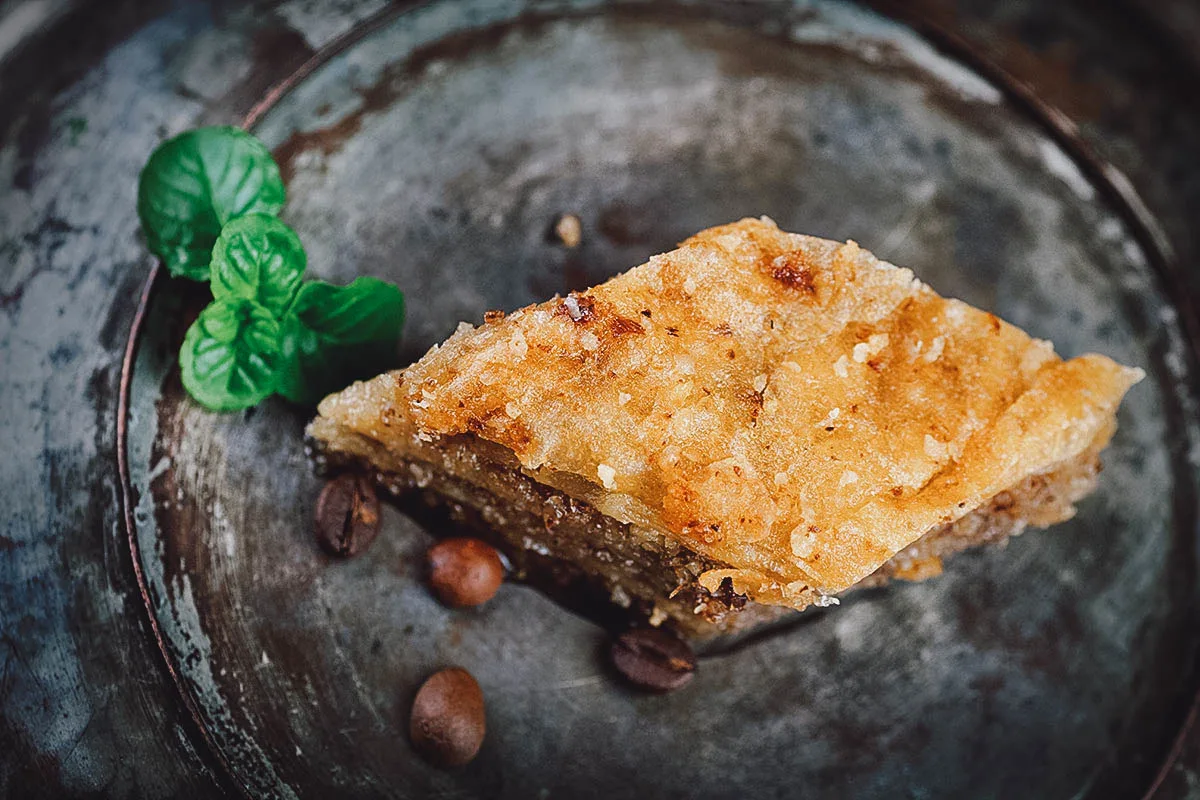
Photo by mythja
17. Krofne
Krofne (or krafne, krofi) refers to a type of doughnut popular in the cuisines of many Balkan countries like Bosnia and Herzegovina, Serbia, Slovenia, Croatia, North Macedonia, and Albania. They’re similar to Berliners or beignets and can be filled with a variety of ingredients like marmalade, jam, chocolate, nutella, or cinnamon.
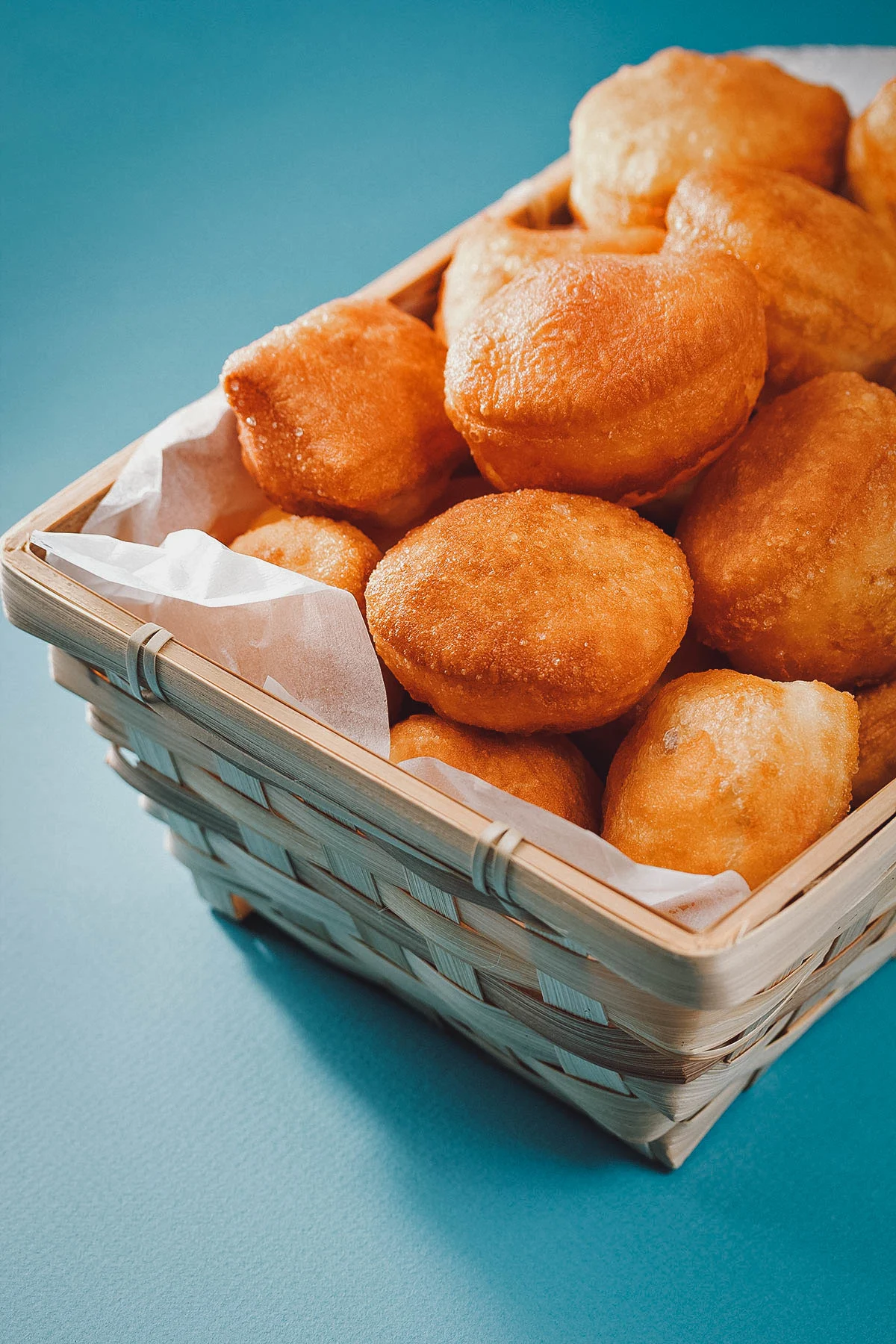
Photo by Melica
18. Knedle
Knedle is a type of dessert made from boiled potato dumplings filled with plums or apricots. It’s derived from the German knödel meaning “dumpling” and is popular in the cuisines of many Central and Eastern European countries like Bosnia and Herzegovina, Poland, Hungary, Romania, Czechia, and Slovakia.
To prepare, a dough made from mashed potatoes, eggs, and flour is flattened out and cut into squares. Plums or apricots are then wrapped in the sheets of dough and boiled. When ready, they can be sprinkled with sugar or cinnamon or covered in breadcrumbs and fried in butter.
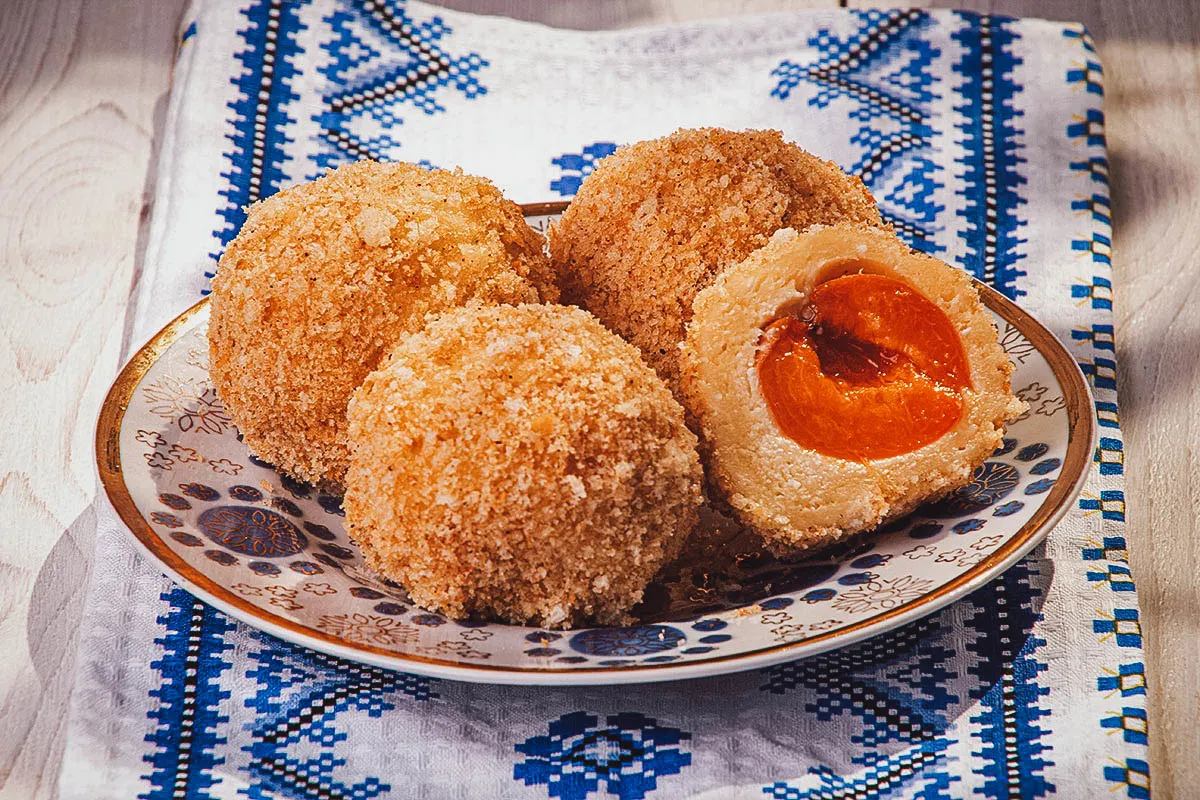
Photo by karamba70
19. Tufahija
“How do you like them apples?” If you like them a lot, then you’re going to love tufahija, a Bosnian dessert made with walnut-stuffed apples poached in sugar water. Popular in Bosnia and Herzegovina, Serbia, Croatia, and North Macedonia, these scrumptious poached apples are usually topped with whipped cream and enjoyed with coffee.
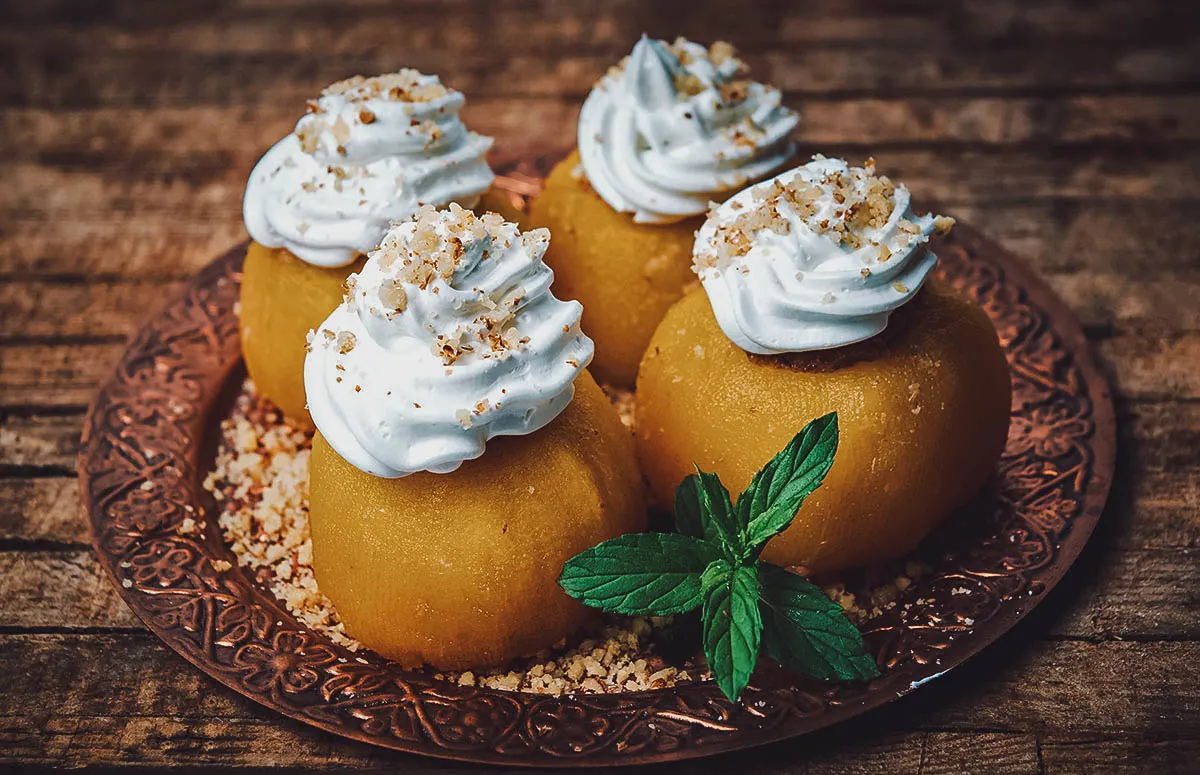
Photo by CreativeFamily
20. Bosanska Kafa
After a satisfying meal of traditional Bosnian food, what better way to punctuate your meal than with a hot cup of bosanska kafa or Bosnian coffee? Similar to Turkish coffee but slightly thinner, it’s a robust and intense cup of joe made with finely ground roasted coffee beans.
Bosanska kafa is traditionally prepared in a copper-plated pot with a long-neck called a džezva. Served in small espresso cups, it’s widely consumed throughout the Balkans, the Middle East, and North Africa.
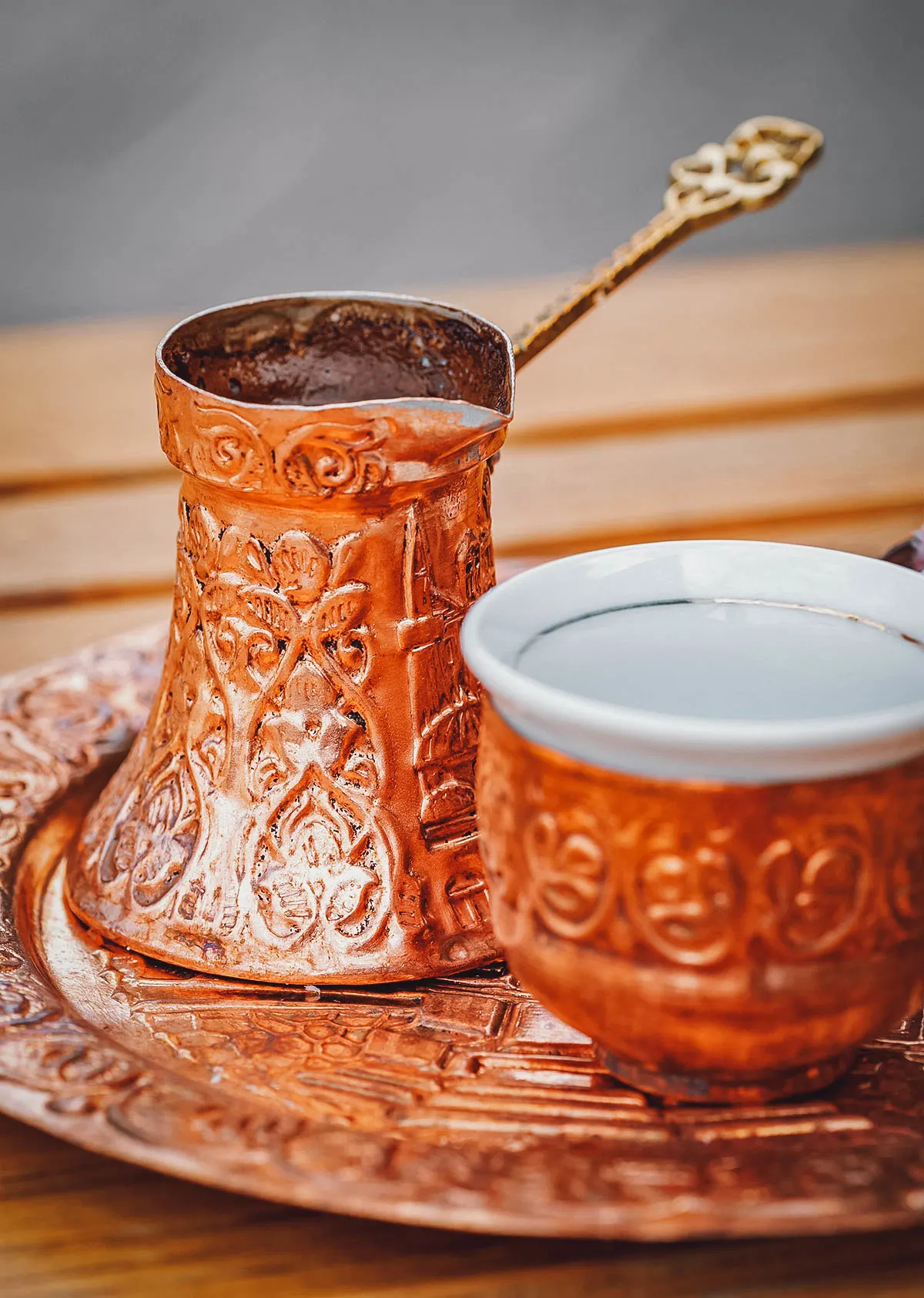
Photo by mazzzur
BOSNIAN FOOD TOURS
Simply put, no one knows Bosnian food better than a local, so what better way to experience the best of Bosnian cuisine than by going on a food tour? Not only will a local take you to the city’s best spots, but they’ll be able to explain all the dishes to you in more detail. Check out Get Your Guide for a list of Bosnian food tours in Sarajevo and other destinations in the country.
FINAL THOUGHTS ON BOSNIAN FOOD
People can often be wary of places they know little about. In spite of its war-torn past, Bosnia and Herzegovina is a safe country to visit and offers plenty to people willing to go the less beaten path. If you enjoy history, nature, and good Balkan food, then you’ll find that there’s much to be excited about in Bosnia and Herzegovina.
Disclosure
Some of the links in this Bosnian food guide are affiliate links. If you make a booking, then we’ll earn a small commission at no additional cost to you. As always, we only recommend products and services that we use ourselves and firmly believe in. We really appreciate your support as it helps us make more of these free travel and food guides. Thank you!
Cover photo by stevanovicigor. Stock images via Depositphotos.


Gina
Thursday 12th of October 2023
Thank you! I have a friend from Bosnia and he's always making this delicious food! I wanted to learn more.
JB & Renée
Saturday 21st of October 2023
You're welcome Gina!